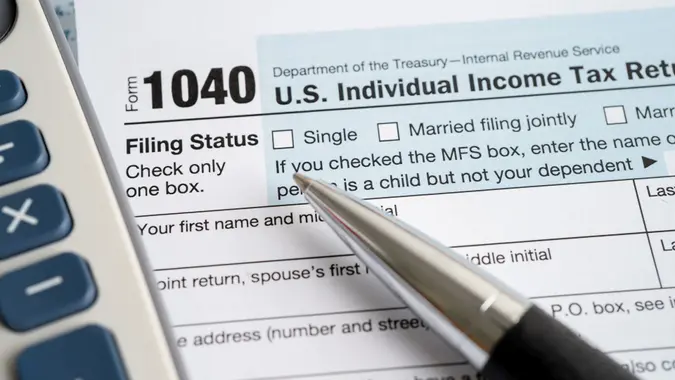5 Things You Can Still Do Now To Minimize Your 2025 Tax Bill

Commitment to Our Readers
GOBankingRates' editorial team is committed to bringing you unbiased reviews and information. We use data-driven methodologies to evaluate financial products and services - our reviews and ratings are not influenced by advertisers. You can read more about our editorial guidelines and our products and services review methodology.

20 Years
Helping You Live Richer

Reviewed
by Experts

Trusted by
Millions of Readers
One of the worst ways to start the new year is with holiday debt and a looming tax bill. However, whether it’s adjusting contributions or planning deductions, small, year-end actions can lead to bigger rewards later.
Here are five things you can still do now to minimize your 2025 tax bill.
Also see five money moves wealthy people make before the start of any new year.
Review Previous Tax Bills
You don’t have to wait until you prepare your taxes to know how much you owe.
“If you had to write a big check last year, you would want to adjust your withholding,” said Colleen Carcone, CFP, director of wealth planning strategies at TIAA. “Reviewing your tax picture throughout the year can help avoid any surprises in April.”
In addition, throughout the year, taxpayers can compare their income and deductions to those of the previous year. Review paystubs for income and withholding and compare them with the previous year’s.
Taxpayers can use the IRS’ online account portal to check the payoff amount, account balance, payment history and digital copies of select notices.
Search Your Home
Many taxpayers can find tax deductions in their everyday environment.
“If you work out of your house and can take the home office deduction, go back and document all repairs, maintenance, utilities and renovations,” said Kevin Jerry, a real estate tax professional who specializes in tax method changes and founder of KAJMST. “If you use your car for business, calculate the actual cost of repairs, oil, gas, tire repairs, etc.”
Fully Fund Your Retirement Accounts
You can also establish automatic payments to your traditional IRA and other tax-advantaged accounts.
“Fully fund your IRA, Roth IRA and 401(k),” Jerry said. “It’s the best way to reduce taxes.”
According to Thrivent, a financial services company, contributing up to $7,000 to your IRA could reduce your current taxable income by $7,000 and put you in a lower tax bracket, saving you money on your 2025 tax bill.
“Once this is set up, don’t touch it,” Jerry said.
Give Generously
Don’t forget about donations and charitable giving.
Another easy tip people often forget to lower their tax bill is to get a receipt for the items they drop off at Goodwill. “Total all of your charitable giving, especially if you dropped clothes off at Goodwill,” Jerry said. “Take a percentage of the original cost as a tax deduction.”
However, Carcone said that while contributions to a qualified charitable organization can be deducted from income as an itemized deduction, not all charitable gifts are equal.
Many people also write checks or make charitable gifts by credit card. However, Carcone said taxpayers under the age of 70 1/2 can consider giving appreciated securities to their favorite organization instead.
“For example, if you bought a share of stock for $50 and it is now worth $100, you can transfer that share of stock to your favorite organization and recognize the $100 deduction without realizing the $50 capital gain,” she said. “With a high standard deduction amount, many taxpayers are not itemizing deductions and do not receive a tax benefit for the charitable gifts that they make. Those taxpayers could consider using qualified charitable deductions.”
Doing so allows taxpayers over the age of 70 1/2 to direct funds from their IRA to a charity. The donations can offset the taxable amount of any required minimum distributions (RMD) and reduce their taxable income for the year.
‘Bunch’ Charitable Donations
Another tip for donating to meaningful causes while lowering next year’s tax bill is to “bunch” charitable donations.
“For example, if married taxpayers have $10,000 of state and local tax deductions, $8,000 of mortgage interest, and usually makes $4,000 of charitable gifts each year, they will only have $22,000 of itemized deductions,” Carcone said. “For married taxpayers under the age of 65, the standard deduction in 2024 is $29,200.”
However, Carcone said the same taxpayer could make three years’ worth of gifts in 2023, bringing their itemized deductions to $30,000.
“They could take the itemized deduction in 2024 and have already made their charitable gifts for 2025 and 2026, when they could take the standard deduction,” Carcone said.
 Written by
Written by  Edited by
Edited by 

























